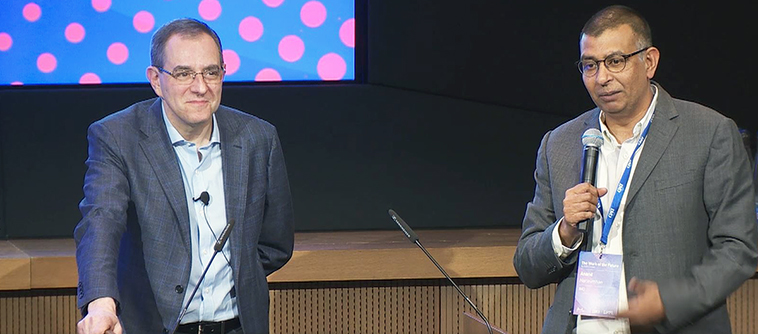In an age of rapidly advancing technology, where will new jobs come from? What will happen to the old ones? Will machines replace us, make us more productive, or augment our skills?
These key questions, and the trends that are driving them, were tackled head on by David Autor, Ford Professor at MIT’s Department of Economics during the first event organized by the Enterprise for Society Center (E4S), a joint initiative between the University of Lausanne (UNIL), the International Institute for Management Development (IMD) and the Ecole Polytechnique Fédérale de Lausanne (EPFL).
The Center will promote dialogue between researchers and practitioners working with technology and socio-economic issues to solve some of the world’s greatest challenges. One of these challenges, of course, is how skills and education can keep pace with the changing nature of work.
The Great Transition
“We are preparing for the great transition towards the economy of the future,” said EPFL Professor and E4S Managing Director Jean-Pierre Danthine, opening the event, ‘The Work of the Future: Shaping Technology and Society’.
There are two major forces that are changing the nature of jobs, added Rafael Lalive, Professor of Economics at the University of Lausanne. “One is that technology is getting better and better. And it replaces many of the things we once did. The second is the fact that we have invented these technologies for a reason – to make us better. My smartphone, for example, helps me coordinate things better than my brain can handle.
“So what do we do with this?” he asked. “We cannot just sit still. We can identify people who are at risk and suggest new skills to help them be resilient … We collaborate. We also communicate, not only to the research community but to the business leaders and society.”
More automation, more jobs
David Autor, whose research has focused on the impacts of technological change on job polarization, skills, wages and inequality, began by drawing our attention to an important paradox.
“Many of the great inventions of the last 200 years were designed specifically to replace labor,” he said. “The tractor was built to replace animal and human muscle power with internal combustion power. The assembly line was designed to replace slow artisanal labor with machine precision.
“And all these technologies have worked,” he added. “We have displaced an enormous amount of human labor and expertise.”
Why, then, has the share of the adult population in the workforce increased in most advanced economies in almost every decade throughout the last century? As we’ve automated, how have we also managed to raise employment?
One contributing factor of course is the entry of more women into the labor force, but what does this paradox mean for the future? Why aren’t we doing less, and why are there still so many jobs?
“The short answer is ‘complimentarity’,” said Autor. “Most work involves a range of tasks, not a single repetitive activity. And as we automate some of those tasks, we increase the value of the tasks that remain.”
“Technology magnifies the scope of your decisions and makes them more important, and so gives additional leverage to ideas, judgment and creativity. So machines don’t just replace us, they also complement us.”
Where does ‘new work’ come from?
It’s also true that, as technology raises productivity and displaces some jobs and skills, “the combination of rising income, greater technological potential and human creativity creates additional demands and needs,” said Autor. “As we get wealthier, we find new things to consume and that creates work.”
Autor also explained how the ‘Uber effect’, the production of a better or cheaper product, often kick-starts the job creation process.
The ‘Walmart-effect’, meanwhile, occurs when all of our fundamental needs have been met and we begin to see other needs and opportunities arise, and the ‘Network effect’ arises when productivity growth in one industry raises demand in customer and supplier industries.
The most fundamental and elusive factor behind job creation, however, is the invention of ‘new work’ which has a level of variety that currently does not exist.
So while we can assume that new jobs will emerge, it’s extremely difficult to predict what they will look like, said Autor. “What characteristics will it have and what skills will it use? That’s a profoundly hard question to answer, but it’s essential to this puzzle.”
Why worry?
So if the rise of machines and human behavior means that there will always be new jobs, what is there to worry about?
“There is no question that technological progress will deliver rising productivity, but it’s an open question as to whether the fruits of this rising productivity will reach the typical worker,” Autor said.
The polarization of work is also cause for concern. While specialized managerial and technical jobs are growing, repetitive middle-skill jobs are in decline. “This has the effect of knocking out rungs in the economic ladder and contributes to the erosion of the middle-class.”
Another concern, Autor said, is “the remarkable growth of earnings inequality,” which “is not coming from the top 1 percent, but from the staggering differences in earning level by education.”
A third cause for concern is the disconnect between productivity and earnings in the US, which decoupled after the 1970s. “The problem is not a lack of jobs,” said Autor, “it’s not a lack of productivity. It’s the distribution of jobs and opportunities.”
Solutions
One way to meet these challenges is to “keep raising skills at the pace of technological advancement,” said Autor. “We need to change the nature of our skills to continue to be complemented by them.”
A second solution is to “align incentives to invest in both physical capital and human capital. We provide excessive incentives for firms to buy machines rather than invest in workers.”
Innovation should also be directed towards raising productivity, not simply displacing labor. “A lot of the technologies that we are developing are amazing,” he said. “They’re cool, but they may not be addressing the most fundamental problems like raising productivity.”
Finally, it’s essential that governments and the private sector take action to address labor scarcity. “Many people are worried about the end of work,” he said, “I’m more worried about the falling number of available workers.” Ageing populations and old age dependency ratios are rising steeply, and as people become better educated they are less willing to become carers, while governments are reducing immigration. “We face labor scarcity for decades to come. We need to raise productivity in ways we haven’t been good at in the past.”
“There will be plenty of work to do, but job quantity does not guarantee job quality … In the past we invested in ourselves in a way that made us complementary by raising education and by changing our institutions to create and share the prosperity that follows,” he said.
“The future will not take care of itself – this is your job.”
Watch the full event here.



